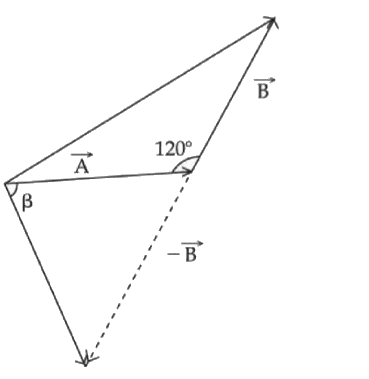Given : →P=→A+→Band→Q=→A−→B. If the magnitudes of vectors →Pand→Q are equal, what is the angle between vectors →Aand→B?
The correct Answer is:C
To solve the problem, we need to find the angle between vectors →A and →B given that the magnitudes of vectors →P and →Q are equal. We start with the definitions of the vectors:
1. Define the vectors:
→P=→A+→B
→Q=→A−→B
2. Set up the equation for magnitudes:
Since the magnitudes of →P and →Q are equal, we can write:
|→P|=|→Q|
3. Express the magnitudes:
The magnitude of →P is given by:
|→P|=√|→A|2+|→B|2+2|→A||→B|cosθ
where θ is the angle between →A and →B.
Similarly, the magnitude of →Q is:
|→Q|=√|→A|2+|→B|2−2|→A||→B|cosθ
4. Set the magnitudes equal:
Since |→P|=|→Q|, we have:
√|→A|2+|→B|2+2|→A||→B|cosθ=√|→A|2+|→B|2−2|→A||→B|cosθ
5. Square both sides to eliminate the square roots:
|→A|2+|→B|2+2|→A||→B|cosθ=|→A|2+|→B|2−2|→A||→B|cosθ
6. Simplify the equation:
Cancel out |→A|2+|→B|2 from both sides:
2|→A||→B|cosθ=−2|→A||→B|cosθ
7. Combine like terms:
2|→A||→B|cosθ+2|→A||→B|cosθ=0
This simplifies to:
4|→A||→B|cosθ=0
8. Solve for cosθ:
Since |→A| and |→B| are not zero, we can divide by 4|→A||→B|:
cosθ=0
9. Determine the angle:
The angle θ for which cosθ=0 is:
θ=90∘
Thus, the angle between vectors →A and →B is 90∘.
→P=→A+→B
→Q=→A−→B
Since the magnitudes of →P and →Q are equal, we can write:
|→P|=|→Q|
The magnitude of →P is given by:
|→P|=√|→A|2+|→B|2+2|→A||→B|cosθ
where θ is the angle between →A and →B.
|→Q|=√|→A|2+|→B|2−2|→A||→B|cosθ
Since |→P|=|→Q|, we have:
√|→A|2+|→B|2+2|→A||→B|cosθ=√|→A|2+|→B|2−2|→A||→B|cosθ
|→A|2+|→B|2+2|→A||→B|cosθ=|→A|2+|→B|2−2|→A||→B|cosθ
Cancel out |→A|2+|→B|2 from both sides:
2|→A||→B|cosθ=−2|→A||→B|cosθ
2|→A||→B|cosθ+2|→A||→B|cosθ=0
This simplifies to:
4|→A||→B|cosθ=0
Since |→A| and |→B| are not zero, we can divide by 4|→A||→B|:
cosθ=0
The angle θ for which cosθ=0 is:
θ=90∘
Similar Questions
Knowledge Check
If ∣∣→P+→Q∣∣=∣∣→P∣∣−∣∣→Q∣∣ , the angle between the vectors →Pand→Q is
A0∘B90∘C180∘D45∘if ∣∣→P+→Q∣∣=∣∣→P∣∣+∣∣→Q∣∣ , the angle between the vectors →Pand→Q is
A0∘B180∘C60∘D90∘The resultant of →P and →Q is perpendicular to →P. What is the angle between →P and →Q
Acos−1(P/Q)Bcos−1(−P/Q)Csin−1(P/Q)Dsin−1(−P/Q)
The vector →a+→b bisects the angle between the non-collinear vectors →aand→b, if……..
View SolutionIf ∣∣→a+→b∣∣=∣∣→a−→b∣∣, then the vectors →aand→b are orthogonal
View SolutionIf →aand→b are two vectors such that ∣∣→a×→b∣∣=→a.→b, then what is the angle between →aand→b ?
View SolutionThe vector →A and →B are such that ∣∣→A+→B∣∣=∣∣→A−→B∣∣. The angle between vectors →A and →B is -
View SolutionIf →P.→Q=PQ then angle between →P and →Q is
View Solution


